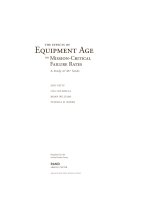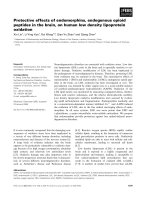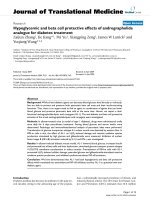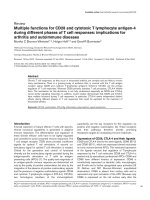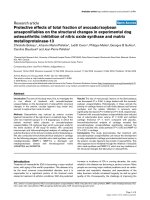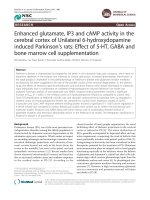Protective effects of hydrogen sulfide against 6 hydroxydopamine induced cell injury implication for treatment of parkinsons disease
Bạn đang xem bản rút gọn của tài liệu. Xem và tải ngay bản đầy đủ của tài liệu tại đây (1.76 MB, 123 trang )
PROTECTIVE EFFECTS OF HYDROGEN SULFIDE AGAINST
6-HYDROXYDOPAMINE-INDUCED CELL INJURY
-IMPLICATION FOR TREATMENT OF PARKINSON'S DISEASE
TIONG CHI XIN
(B.Sc. (Biomedical Sciences), University Putra Malaysia, Malaysia)
A THESIS SUBMITTED
FOR THE DEGREE OF MASTER OF SCIENCE
DEPARTMENT OF PHARMACOLOGY
NATIONAL UNIVERSITY OF SINGAPORE
2011
i
ACKNOWLEDGEMENTS
I would like to express my heartfelt gratitude to my supervisor, Prof Bian Jin-Song,
for giving me the opportunity to work on this research project. I would also like to
thank my supervisor for his invaluable supervisions, enlightening ideas, continuous
support and guidance throughout the course of this endeavor.
I am grateful to my seniors, Dr Lu Ming and Dr Hu Li Fang for their
encouragement, technical help and critical comments. Sincere appreciation also to all
the laboratory members, Xie Li, Wu Zhiyuan, Liu Yihong, Koh Yung Hua, Yong
Qian Chen, Hua Fei, Bhushan Nagpure, Shoon Mei Leng and other friends in Prof
Bian’s lab for their technical support, assistance in various aspects as well as their
warm friendship. Their presence has made the laboratory an enjoyable place to work
in.
I would also like to thank my family members and friends for their constant
support and encouragement.
ii
TABLE OF CONTENT
ACKNOWLEDGEMENTS ........................................................................................ i
PUBLICATIONS ....................................................................................................... vi
SUMMARY ............................................................................................................... vii
LIST OF TABLES ..................................................................................................... ix
LIST OF FIGURES .................................................................................................... x
ABBREVIATIONS ................................................................................................... xii
CHAPTER 1 INTRODUCTION ............................................................................... 1
1.1 General Overview ................................................................................................... 1
1.2 Parkinson’s disease (PD) ........................................................................................ 2
1.2.1 Epidemiology ................................................................................................. 3
1.2.2 Risk factors .................................................................................................... 4
1.2.3 Pathology and pathogenesis ........................................................................... 5
1.2.3.1 Pathology .............................................................................................. 5
1.2.3.2 Pathogenesis.......................................................................................... 7
1.2.4 Clinical features and diagnosis .................................................................... 13
1.2.5 Treatment ..................................................................................................... 13
1.2.6 6-hydroxydopamine (6-OHDA) experimental model .................................. 17
1.3 Hydrogen sulfide (H 2 S) ........................................................................................ 20
1.3.1 Physical and chemical properties of H 2 S..................................................... 20
1.3.2 Toxicology of H 2 S ....................................................................................... 21
1.3.3 Endogenous generation and metabolism of H 2 S in mammals..................... 23
iii
1.3.4 Neuropathology of H 2 S ............................................................................... 28
1.3.5 Neurophysiological roles of H 2 S ................................................................. 30
1.3.5.1 H 2 S as a neuromodulator .................................................................... 30
1.3.5.2 H 2 S as a neuroprotectant .................................................................... 32
1.3.6 H 2 S and endoplasmic reticulum (ER) stress ................................................ 35
1.4 SH-SY5Y cells ...................................................................................................... 37
1.5 Research rational and objectives........................................................................... 38
CHAPTER 2 H 2 S PROTECTS AGAINST 6-OHDA-INDUCED CELL
INJURY …………………………………………………………………………….40
2.1 Introduction ........................................................................................................... 40
2.2 Materials and methods .......................................................................................... 41
2.2.2 Cell culture ................................................................................................... 42
2.2.3 Cell treatment ............................................................................................... 42
2.2.4 Cell viability assay ....................................................................................... 42
2.2.5 Cell fractionation for determining PKC isoform translocation.................... 43
2.2.6 Preparation of cell lysates for the detection of TH and phosphorylated Akt
..... ………………………………………………………………………………..43
2.2.7 Western blot assays ...................................................................................... 44
2.2.8 Cell transfection and apoptotic detection..................................................... 44
2.2.9 H 2 S measurement ........................................................................................ 45
2.2.10 Statistical analysis ...................................................................................... 46
2.3 Results ................................................................................................................... 47
2.3.1 H 2 S protects against 6-OHDA-induced cell injury ..................................... 47
iv
2.3.2 H 2 S reverses 6-OHDA-induced loss of TH ................................................. 49
2.3.3 H 2 S regulates translocation of PKC isoforms in 6-OHDA-treated SH-SY5Y
cells ....................................................................................................................... 50
2.3.4 Effect of NaHS on cell viability in 6-OHDA-treated SH-SY5Y cells in the
presence and absence of inhibitors of PKC isoforms ........................................... 50
2.3.5 H 2 S-induced neuroprotection involves PI3K/Akt activation ...................... 54
2.3.6 Correlation between PKC and Akt .............................................................. 54
2.3.7 CBS overexpression attenuates 6-OHDA-induced apoptosis in SH-SY5Y
cells ....................................................................................................................... 58
2.4 Discussion ............................................................................................................. 61
CHAPTER
3
H2S
PROTECTS
AGAINST
6-OHDA-INDUCED
ENDOPLASMIC RETICULUM (ER) STRESS.................................................... 65
3.1 Introduction ........................................................................................................... 65
3.2 Materials and methods .......................................................................................... 66
3.2.1 Chemicals and reagents................................................................................ 66
3.2.2 Cell culture ................................................................................................... 67
3.2.3 Cell treatment ............................................................................................... 67
3.2.4 Cell viability assay ....................................................................................... 68
3.2.5 Western blot assays ...................................................................................... 68
3.2.6 Reverse transcription-PCR........................................................................... 69
3.2.7 Statistical analysis ........................................................................................ 70
3.3 Results ................................................................................................................... 72
3.3.1 H 2 S protects SH-SY5Y cells against 6-OHDA-induced cell death............. 72
v
3.3.2 H 2 S decreases p-eIF2α expression induced by 6-OHDA ............................ 74
3.3.3 H 2 S decreases BiP mRNA expression induced by 6-OHDA ...................... 76
3.3.4 H 2 S decreases CHOP expression induced by 6-OHDA .............................. 78
3.3.5 Akt activity, but not ERK1/2, mediates the protective effect of H2S on 6OHDA-induced ER stress in SH-SY5Y cells ....................................................... 78
3.3.6 Hsp90 mediates the protective effects of H 2 S on 6-OHDA-induced ER
stress in SH-SY5Y cells ........................................................................................ 81
3.3.7 Interaction between Akt kinase and Hsp90 molecular chaperone ............... 83
3.4 Discussion ............................................................................................................. 84
CHAPTER 4 GENERAL DISCUSSION AND CONCLUSION .......................... 88
4.1 General discussion ................................................................................................ 88
4.2 Conclusion ............................................................................................................ 92
REFERENCES.......................................................................................................... 93
vi
PUBLICATIONS
Tiong CX, Lu M, Bian JS. Protective effect of hydrogen sulphide against 6-OHDAinduced cell injury in SH-SY5Y cells involves PKC/PI3K/Akt pathway. Br J
Pharmacol 2010, 161:467-480
Xie L*, Tiong CX*, Bian JS. Hydrogen sulfide protects SH-SY5Y cells against 6hydroxydopamine-induced endoplasmic reticulum (ER) stress. Am J Physiol - Cell
Physiol (In Press)
Hu LF, Lu M, Tiong CX, Dawe GS, Hu G, Bian JS. Neuroprotective effects of
hydrogen sulfide on Parkinson's disease rat models. Aging Cell 2010, 9:135-146
Lu M, Liu YH, Ho CY, Tiong CX, Bian JS. Hydrogen sulfide regulates cAMP
homeostasis and renin degranulation in As4.1 and rat renin-rich kidney cells. Am J
Physiol- Cell Physiol 2012, 302(1):C59-66
Xie L, Hu LF, Tiong CX, Sparatore A, Del Soldato P, Dawe GS, Bian JS.
Therapeutic effect of ACS84 on 6-OHDA-induced Parkinson’s disease rat model.
(Ready for submission)
*
These authors contributed equally to this work
vii
SUMMARY
Parkinson's disease (PD), the second most common neurodegenerative disease, is
caused by the progressive loss of dopaminergic neurons in the substantia nigra,
accompanied by an alteration in the dopamine concentration in the striatum.
Hydrogen sulfide (H 2 S), the newest member of the gasotransmitter family, serves as
an important neuromodulator in regulation of the brain functions. The present study
aimed to investigate the protective effect of H 2 S against cell injury induced by 6hydroxydopamine (6-OHDA), a selective dopaminergic neurotoxin often used to
establish a model of PD.
The effect of H 2 S on neurotoxin, 6-OHDA was first examined. It was found
that the exposure to 6-OHDA at 50-200 µM for 12 h decreased cell viability of SHSY5Y cells. Exogenous application of NaHS (an H 2 S donor) at 100-1000 µM or
overexpression of cystathionine β-synthase (a predominant enzyme to produce
endogenous H 2 S in SH-SY5Y cells) protected cells against 6-OHDA-induced cell
apoptosis and death. NaHS (100 µM) also reversed the up-regulation of cleaved poly
(ADP-ribose) polymerase (PARP) in 6-OHDA (50 µM)-treated cells. Furthermore,
NaHS reversed 6-OHDA-induced loss of tyrosine hydroxylase, the rate-limiting
enzyme for dopamine production. The underlying signaling mechanisms for H 2 S
protection are associated with the activation of PKCα,ε and PI3K/Akt pathway. In
addition, blockade of PKCα and ε with their specific inhibitors significantly
attenuated NaHS-induced Akt phosphorylation, suggesting that activation of Akt by
NaHS is PKCα, ε-dependent.
viii
As endoplasmic reticulum (ER) stress has been indicated as a potential
mediator of PD, the effect of H 2 S on 6-OHDA-induced ER stress was also examined
in this study. Consistent with its cytoprotection, NaHS markedly reduced 6-OHDAinduced ER stress responses, including up-regulation of phospho-eIF2α, BiP mRNA
level and CHOP protein expression level. The protective effect of NaHS against ER
stress was mediated by Akt and Hsp90. Interestingly, a decrease in the levels of
Hsp90 upon inhibition of Akt activity was observed, suggesting that activation of Akt
by NaHS may stimulate Hsp90 protein expression.
In conclusion, the present study demonstrate for the first time that H 2 S may
protect against cell injury and ER stress induced by 6-OHDA neurotoxin via multiple
signaling mechanisms and therefore has the potential therapeutic value for PD
treatment.
ix
LIST OF TABLES
Table 1.1 Various treatments for Parkinson’s disease………………………………17
Table 1.2 Human health effects at various H 2 S concentrations……………………..21
Table 1.3 Neuropathological roles of H 2 S…………………………………………..27
Table 3.1 Primers for PCR reactions………………………………………………...69
x
LIST OF FIGURES
Figure 1.1 Schematic paradigms for multiple factors involved in ER stress in the
pathogenesis of PD…………………………………………………………………..10
Figure 1.2 Schematic representation of the endogenous H 2 S biosynthesis…………25
Figure 2.1 MTT assay showing the effect of NaHS and/or 6-OHDA on SH-SY5Y
cell viability………………………………………………………………………….45
Figure 2.2 Effect of NaHS on TH expression in SH-SY5Y cells treated with 6OHDA……………………………………………………………………………..…47
Figure 2.3 Role of PKC isoforms in the neuroprotective effects of NaHS in SHSY5Y cells treated with 6-OHDA…………………………………………………...49
Figure 2.4 The protective effect of NaHS on cell viability in the presence and
absence of various PKC isoforms inhibitors…………………………………………51
Figure 2.5 Involvement of PI3K/Akt pathway in the neuroprotective effects of
NaHS……………………………………………………………………………..…..53
Figure 2.6 Effect of PI3K inhibitor on the NaHS neuroprotection against 6-OHDAinduced cell injury……………………………………………………………………54
Figure 2.7 Effect of NaHS on Akt activation was dependent on PKC
activity…………………………………………………………………….................55
Figure 2.8 Effect of endogenous H 2 S on 6-OHDA-induced cell apoptosis in SHSY5Y cells………………………………………………………………………….. 57
Figure 3.1 Effects of NaHS on 6-OHDA-induced cell injury in SH-SY5Y cells…...71
Figure 3.2 Western blot analysis shows the effects of 6-OHDA and/or NaHS on peIF2α protein expression……………………………………………………………..72
Figure 3.3 RT-PCR shows the effects of 6-OHDA and/or NaHS on the BiP mRNA
level………………………………………………………………………………..…74
Figure 3.4 Effect of 6-OHDA on the CHOP protein expression in the presence or
absence of NaHS……………………………………………………………………..77
Figure 3.5 The neuroprotective effect of NaHS involves Akt but not ERK 1/2
pathway……………………………………………………………………………...78
xi
Figure 3.6 Effect of Geldanamycin and/or NaHS on BiP mRNA expression or Hsp90
protein expression in SH-SY5Y cells………………………………………………..79
Figure 3.7 Blockade of Akt with Akt inhibitor (Akt i ) attenuated the effect of NaHS
on Hsp90 expression…………………………………………………………………81
xii
ABBREVIATIONS
3MST
3-mercaptopyruvate sulfurtransferase
6-OHDA
6-hydroxydopamine
AAAD
Aromatic amino acid decarboxylase
AD
Alzheimer’s disease
ALS
Amyotrophic lateral sclerosis
APAF-1
Apoptotic peptidase activating factor 1
BBB
Blood brain barrier
BiP/Grp78
Binding immunoglobin protein/glucoseregulated protein 78
cAMP
Cyclic-AMP
CAT
Cysteine aminotransferase
CBS
Cystathionine β-synthase
CHOP
C/EBP homologous protein
CNS
Central nervous system
CO
Carbon monoxide
CO 2
Carbon dioxide
COMT
Catechol-O-methyltransferase
CSE
Cystathionine γ-lyase
CT
Computerized tomography
DBS
Deep brain stimulation
DMSO
Dimethyl sulfoxide
xiii
DOPA
Dihydroxyphenylalanine
eIF2α
Eukaryotic initiation factor 2alpha
ER
Endoplasmic reticulum
ERAD
ER-associated degradation
ERK 1/2
Extracellular signal-regulated kinase 1/2
GSH
glutathione
H2O2
Hydrogen peroxide
H2S
Hydrogen sulfide
Hcy
Homocysteine
HD
Huntington’s disease
HHcy
Hyperhomocysteinemia
Hsp90
Heat shock protein 90
IL-1β
Interleukin-1β
IL-6
Interleukin-6
L-Dopa
Levodopa
LPS
Lipopolysaccharide
LTP
Long-term potentiation
MAO-B
Monoamine oxidase B
MAPK
Mitogen-activated protein kinase
MMP
Mitochondrial membrane potential
MPP+
1-methyl-4-phenylpyridinium ion
MPTP
1-methyl-4-phenyl-1,2,3,6-tetrahydropyridine
MRI
Magnetic resonance imaging
xiv
MSA
Multiple system atrophy
NaHS
Sodium hydrogen sulfide
NMDA
N-methyl-D-aspartate
NO
Nitric oxide
PARP
Poly (ADP-ribose) polymerase
PD
Parkinson’s disease
PI3K
Phosphoinositide 3-kinase
PKC
Protein kinase C
PLP
Pyridoxal-5’-phosphate
PrDs
Prion-related disorders
PSP
Progressive supranuclear palsy
ROS
Reactive oxygen species
RSS
Reactive sulfur species
SAM
S-adenosylmethionine
SN
Substantia nigra
TEA
Tetraethyl ammonium
TH
Tyrosine hydroxylase
TNF-α
Tumor necrosis factor-α
UPR
Unfolded protein response
UPS
Ubiquitin-proteasome system
1
CHAPTER 1 INTRODUCTION
1.1 General Overview
Parkinson’s disease (PD) is the second most common neurodegenerative disease
affecting the elderly and is characterized by progressive loss of dopaminergic neurons
in the substantia niagra, accompanied by the alteration of dopamine concentration in
the striatum [1]. Despite years of intensive research, its etiology remains elusive
although several mechanisms have been demonstrated as crucial to PD pathogenesis:
oxidative stress, generation of reactive oxygen species (ROS), endoplasmic reticulum
(ER) stress and apoptosis [2-5]. These pathogenic mechanisms may act
synergistically and be held responsible to promote PD [6].
Paradoxically known as an environmental pollutant, H 2 S is now widely
recognized as a novel “gasotransmitter”, produced naturally in mammalians. H 2 S has
been categorized as the third endogenous gaseous mediator alongside nitric oxide
(NO) and carbon monoxide (CO) as they share similar properties: small gaseous
molecules; membrane permeable; do not act via specific membrane receptors; and are
produced enzymatically [7]. H 2 S could be generated in many mammalian cells with
L-cysteine as substrate and functionally, H 2 S has been implicated in regulating many
bodily functions [7-13]. The turning point started in 1996 when Abe and team first
describe H 2 S as an important endogenous neuromodulator and subsequently in 2004,
H 2 S was found to be a neuroprotectant against oxidative stress [12, 14]. These two
key findings have opened up a whole new area in exploring the important roles of
H 2 S in regulating the central nervous system (CNS) functions.
2
For the past decade, researchers have shown growing interest in the
physiological and pathological functions of H 2 S in many systems, which varies from
the brain to the gut [15]. However, the role of H 2 S in neuroprotection against PD has
not been documented. Therefore, this thesis was designed to investigate the potential
role of H 2 S on 6-hydroxydopamine (6-OHDA)-induced cell death and endoplasmic
reticulum (ER) stress in human dopaminergic neurons.
1.2 Parkinson’s disease (PD)
First described by British physician, James Parkinson in 1817 as paralysis agitans or
the ‘shaking palsy’ [16], Parkinson’s disease (PD) is now the second most common
age-related neurodegenerative disorder after Alzheimer’s disease (AD). PD patients
suffer from bradykinesia, ridigity, resting tremor, slowing of movement and postural
instability [17, 18]. Several non-motor symptoms are also common such as
swallowing and speech, which seriously affect the quality of life. Apart from motor
deficits symptoms, some patients with PD also exhibit cognitive dysfunction. In
extreme cases, PD individuals suffer from dementia. Also in about 40% of PD
patients, depressive symptomatology has been recognized [17, 18].
PD is a result of progressive loss of dopaminergic neurons in the substantia
nigra pars compacta (SN), accompanied by an alteration of dopamine concentration in
the striatum [1]. The aetiology remains incompletely elucidated, although oxidative
damage, generation of reactive oxygen species (ROS) [19], mitochondrial
dysfunction, misfolded protein aggregation, ubiquitin-proteasome system (UPS) [20]
and endoplasmic reticulum (ER) stress [4, 21, 22] might be responsible for its
3
pathogenesis. At present, levodopa (L-Dopa) is widely used as a treatment to restore
dopamine concentration in PD patients [23]. However, long-term usage of L-Dopa
does not arrest the progress of PD and long term treatment will induce side effect
like dyskinesia [24-26] and accelerate the neuron degeneration due to the
enhancement of oxidative stress [27-30]. Therefore, it is of great importance to
understand the cause of PD as it could help to develop new potent therapies for PD.
1.2.1
Epidemiology
PD is the second most common neurodegenerative disease after Alzheimer’s disease.
According to National Institutes of Health’s fact sheet updated in October 2010,
about half a million people worldwide have been diagnosed with PD and
approximately 50,000 new cases are diagnosed each year in the U.S.
( Fact Sheet.aspx?csid=109). In the local
context, according to Singapore Health Services (SingHealth), PD occurs in
Singaporean as commonly as in the West. Three out of every thousand individuals,
aged
50
years
and
above,
have
this
disease
(ghealth.
com.sg/PatientCare/ConditionsAndTreatments/Pages/Parkinsons-Disease-MovementDisorders.aspx).
PD is an age-related disease. It is rare before age 50 years and the prevalence
increases from 1% in people over 60 years of age, up to 4% in those over 80 years of
age [31]. The mean age for PD onset is around 60 years of age, although there are
about 5-10% cases whereby the onset of PD is at a much earlier age, which is
between 20 and 50 [32].
4
Some studies have proposed that PD may be more prevalent in men than in
women [31, 33], although other studies have failed to identify significant differences
between these two genders [31]. Oestrogen as the source of neuroprotection has been
suggested as a possible explanation for a lower risk in women than in men, but their
role is still controversial [31]. Apart from that, issue of ethnicity in relation to
occurrence of PD addressed that PD might be less prevalent in African and Asian
ancestry compared to Caucasians. This finding is however, conflicting as the
differences could be contributed by differences in response rates, survival and caseascertainment [31].
1.2.2 Risk factors
Some researchers speculated that genetic or environmental factors may contribute to
PD neuronal damage while other researchers labeled it as idiopathic (unknown cause).
No one primary cause of PD is yet to be identified, although several risk factors are
clearly evident.
Advancing age is one of the main risk factors of PD. Young adults rarely
experience PD although it is not impossible to develop PD at an earlier age. PD
generally manifests itself in the middle to late years of life. The risk continues to
increase as one grows older.
PD is heritable. Reseachers have demonstrated that mutated parkin [34],
PINK1 [35], DJ-1 [36] and α-synuclein [37] genes are directly associated with early
onset of PD. Therefore, individuals with siblings or parents who developed
Parkinson's at a younger age are at higher risk for PD.
5
Ongoing exposure to toxins such as pesticides and herbicides puts one at a
greater risk to PD. Some of the pesticides contained rotenone which inhibit dopamine
production and promote free radical damage. Those involved in farming are therefore
having a greater prevalence of Parkinson's symptoms.
Oestrogen is postulated to have neuroprotective effect and declining oestrogen
level may increase the risk of PD. Post menopausal who do not use hormone
replacement therapy are at greater risk, as are those who have had hysterectomies. For
this reason also, it is theorized that males are more likely to get PD than females.
1.2.3
Pathology and pathogenesis
1.2.3.1 Pathology
PD is a progressive neurological disorder that results from irreversible degenerative
processes of dopaminergic neurons of the nigrostriatal pathway [38], resulting in
marked motor control impairment. Symptoms of PD become obviously manifested
when approximately 80% of dopamine levels in the striatum are lost [39], with 4050% reduction of the dopaminergic neurons in the substantia nigra (SN) pars
compacta [18, 40].
As the terminals of dopaminergic neurons degenerate, dopamine uptake is
also reduced. However, given the inherent redundancy in dopamine terminals and
dopamine receptors, active compensatory is possible to permit the striatal function to
continue without disruption during early phases of neurodegenerative process [41].
Neurologic deficits become apparent when the availability of dopamine falls below
the required level for compensation or when the system is subjected to certain
6
pharmacologic, environmental or physiologic challenges. With several groups of
dopaminergic neurons in the central nervous system (CNS), it is the loss of the
dopaminergic neurons in the SN that account for the motor manifestation of PD [42].
Interestingly, in most cases neuronal loss is not only restricted to dopaminergic
neurons. Loss of cholinergic neurons of the nucleus basalis of Meynert, may be
responsible, at least in part, for dementia [43].
A relatively specific pathological feature accompanying the neuronal
degeneration in PD is an intracytoplasmic inclusion body, known as the Lewy body.
In almost every case of PD, Lewy body is detected in pigmented neurons of the
substantia nigra (SN) [44]. Other than the SN, localization of Lewy bodies in PD
patients has been found in many areas, including the SN, locus ceruleus, nucleus
basalis, hypothalamus, cerebral cortex, cranial nerve motor nuclei and the central and
peripheral divisions of the autonomic nervous system [37].
A Lewy body is composed of the protein α-synuclein associated with other
proteins such as synphilin [45] and ubiquitin [46]. Mutations (A30P or A53T) or
triplications of α-synuclein
have been detected in some familiar PD patients,
suggesting that mutations may disrupt the normal conformation of this protein,
leading to aggregation [47-49]. Further investigation also indicated that the A30P and
A53T mutants exhibit a higher potential to form oligomers and Lewy body-like fibrils
than wild-type α-synuclein [50]. Wild-type α-synuclein is also found in Lewy body
inclusions in sporadic PD patients, although the mechanism still remains unclear. It
was speculated that the aggregation of wild-type α-synuclein was associated with the
dysfunction of mitochondria complex-I [51-54], tyrosine nitration [55] and the failure
7
of proteasome function [56, 57]. The presence of α-synuclein has been reported to
activate microglia, generating extracellular superoxide and increasing intracellular
ROS [58], and thus potentiating neuronal death [59].
1.2.3.2 Pathogenesis
The pathogenesis of both familial and sporadic PD remains incompletely elucidated,
although oxidative stress and generation of reactive oxygen species (ROS) from
dopamine metabolism, neuroinflammation, and mitochondrial impairment as well as
protein aggregation and misfolding might be responsible for it pathogenesis. No one
mechanism appears to be primary in all cases of PD and these pathogenic
mechanisms may act synergistically through complex interplay to promote
neurodegeneration as depicted in Figure 1.1. Hence, it is the combination of these
contributing factors and dopamine oxidation enhances the vulnerability of
dopaminergic
neurons
in
the
nigrostriatal
tract
and
thus
leads
to
the
neurodegeneration in PD.
Oxidative stress and mitochondrial dysfunction
Oxidative stress results from the presence of overabundance of the reactive oxygen
species (ROS) due to overproduction of ROS or inability of the biological system to
readily detoxify the reactive intermediates. Dopamine can be auto-oxidized to forms
quinones, semiquinones, neuromelanin as well as superoxide, including H 2 O 2 and
reactive hydroxyl radicals [60, 61]. The rich in iron nature of SN provides abundant
ferrous or cupric ions to catalyze the formation of highly reactive hydroxyl radicals
8
from H 2 O 2 [62]. Presence of neuromelanin metabolites alter the ability of the metal
ions and enhance the participation in ROS production [63]. Mitochondrial
dysfunction is another source for ROS production. Although the mechanisms
responsible for mitochondrial dysfunction is not well understood, inherited or
acquired mutations in mitochondrial DNA might contribute to its dysfunction [64-66].
Autopsy has found disminishing activity of mitochondrial complex I in PD patients
[67], while Parkisonian mimetics neurotoxins induced complex I inhibition in animal
models [51, 68, 69]. On top of that, anti-oxidant glutathione proteins are found to be
reduced in postmortem PD nigra [70-72]. Researchers have also found that mutation
in PTEN-induced putative kinase (PINK1) and DJ-1 genes reduce protection against
oxidative stress [35, 73-75].
Neuroinflammation
Neuroinflammation is characterized by the release of proinflammatory cytokines and
free radicals that can be provoked by injury to the brain. Neuroinflammatory
responses are mediated largely by glial cells [76, 77], namely the actived microglia
[78] and to a lesser extent, reactive astocytes [79]. Microglia, as the major contributor
of proinflammatory and neurotoxic factors, are a specialized form of macrophage
residing in the CNS. In 1988, McGeer and co-workers reported the presence of
activated microglia within the substantia nigra of patients with PD at post-mortem
[78]. Another group, Bertrand and co-workers found mild microglial activation in the
locus coeruleus [80]. Activation of microglia in PD is poorly understood, although
substances produced by dying dopaminergic neurons, which includes α-synuclein
9
aggregates [58], neuromelanin [81], adenosine triphosphate (ATP) [82] and matrix
metalloproteinase-3 (MMP-3) [83] can promote microglia activation. Microglia,
when activated in the presence of activating stimuli, produce and release various proinflammatory factors such as nitric oxide (NO) superoxide [84], tumor necrosis
factor-α (TNF-α) [85], interferon γ (IFN- γ) [86] and interleukin-1β (IL-1β) [87],
which could in turn activate the neighboring microglia, leading to a feed forward
cycle aggravating neuroinflammatory processes [88] and irreversible destruction of
SN dopaminergic neurons [89].
Of note, reports have also suggested that the density of astrocytes is lower in
the SN of PD patients. Evidences has shown that PD patients have fewer surrounding
astroglial cells, which function to detoxify oxygen free radicals by glutathione
peroxidase in healthy indivuals [79, 90]. This limited astroglial environment might
also be a contributing factor in PD .
Protein aggregation and misfolding
Following gene transcription and translation, newly synthesized proteins are folded to
achieve native conformations. However, even when natively folded, proteins have a
low margin of stability and are constantly exposed to damaging conditions including
temperature elevation and various post-synthetic modifications (e.g., oxidation,
glycation, and nitrosylation) that could promote their denaturation or in worst case,
accumulate and promote neurodegenerative diseases [91].
As in the case of autosomal dominant familial PD, it was found that αsynuclein, a major component of Lewy body, misfolded. Three missense mutations
10
(A30P, E46K and A53T) were found in the α-synuclein gene [37, 47]. Point mutation,
overexpression and gene triplication, as well as oxidative damage to α-synuclein
promotes self-aggregation and fibrillization of α-synuclein leading to neuronal
dysfunction and dopaminergic neuronal death [92, 93]. Fueling this excitement is the
identification of another PD-linked gene, parkin, an E3 ubiquitin ligase involved in
targeting misfolded proteins for degradation . Like α-synuclein, parkin is also prone
to misfolding and mutation in the parkin, as found in the genetic forms of PD, disrupt
its E3 ubiquitin ligase activity, causing accumulation and aggregation of misfolded
protein [22, 94, 95]. Similarly, protein misfolding may also affects other functions of
PD-linked genes such as PINK1 and DJ-1 [96]. Henceforth, overexpression of the
mutant genes lead to accumulation of unfolded proteins in the lumen of the
endoplasmic reticulum (ER), creating an ER stress environment
Endoplasmic reticulum (ER) stress
The endoplasmic reticulum (ER) is a sophisticated luminal network for the synthesis,
maturation, folding and transportation of proteins destined for cell membrane, Golgi
apparatus, lysosomes, secretion and etc [97, 98]. Proper protein folding is essential in
ensuring cellular functioning. General perturbations including glucose deprivation,
inhibition of protein modification, disturbances of Ca2+ homeostasis as well as
accumulation of unfolded or misfolded proteins in the ER are a threat to cell survival
[99-101]. In order to withstand such potentially lethal conditions, ER stress response
are activated [101] by triggering the cellular unfolded protein response (UPR) [44].
The UPR include translational attenuation, induction of ER resident chaperones, and


